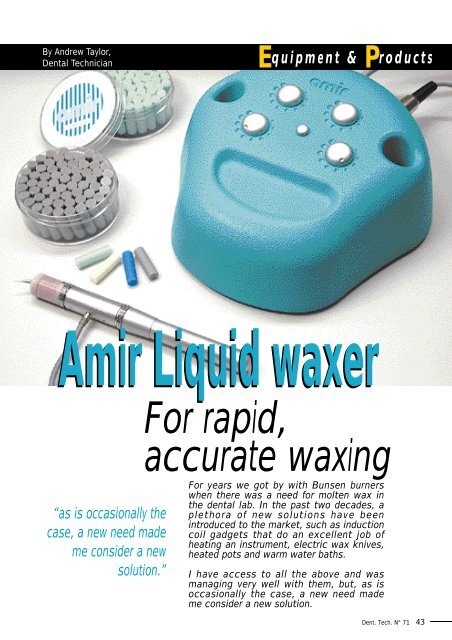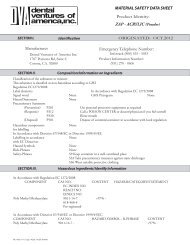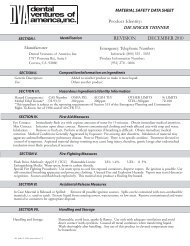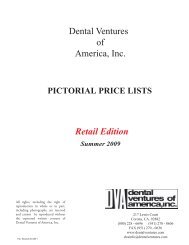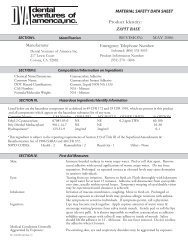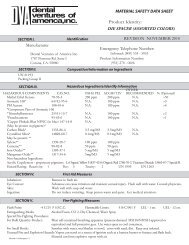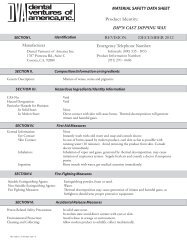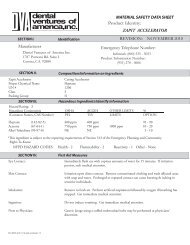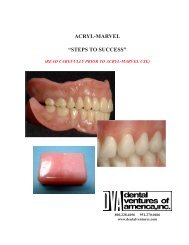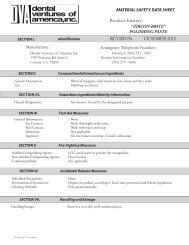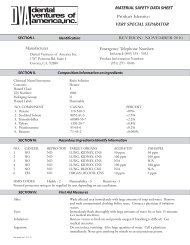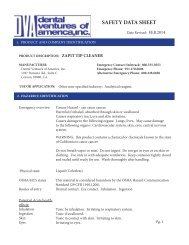DVA's Liquid Waxer system featured in Dent. Tech. - Dental Ventures
DVA's Liquid Waxer system featured in Dent. Tech. - Dental Ventures
DVA's Liquid Waxer system featured in Dent. Tech. - Dental Ventures
You also want an ePaper? Increase the reach of your titles
YUMPU automatically turns print PDFs into web optimized ePapers that Google loves.
By Andrew Taylor,<br />
<strong>Dent</strong>al <strong>Tech</strong>nician<br />
E q u i p m e n t & P r o d u c t s<br />
Amir <strong>Liquid</strong> waxer<br />
For rapid,<br />
accurate wax<strong>in</strong>g<br />
“as is occasionally the<br />
case, a new need made<br />
me consider a new<br />
solution.”<br />
For years we got by with Bunsen burn e r s<br />
when there was a need for molten wax <strong>in</strong><br />
the dental lab. In the past two decades, a<br />
plethora of new solutions have been<br />
<strong>in</strong>troduced to the market, such as <strong>in</strong>duction<br />
coil gadgets that do an excellent job of<br />
heat<strong>in</strong>g an <strong>in</strong>strument, electric wax knives,<br />
heated pots and warm water baths.<br />
I have access to all the above and was<br />
manag<strong>in</strong>g very well with them, but, as is<br />
occasionally the case, a new need made<br />
me consider a new solution.<br />
<strong>Dent</strong>. <strong>Tech</strong>. N° 71 43
E q u i p m e n t & P r o d u c t s<br />
Evolv<strong>in</strong>g needs <strong>in</strong> the lab<br />
There has been a steady <strong>in</strong>crease <strong>in</strong> the number of<br />
diagnostic wax-ups sent to my laboratory. These are<br />
of both the aesthetic and occlusal varieties and I was<br />
f<strong>in</strong>d<strong>in</strong>g cop<strong>in</strong>g with the <strong>in</strong>crease difficult, as diagnostics<br />
is a time consum<strong>in</strong>g bus<strong>in</strong>ess.<br />
I have never counted the number of visits needed by<br />
an <strong>in</strong>strument to a heat source and then the wax, but<br />
clearly, <strong>in</strong> a full mouth case, it can be hundreds.<br />
The time spent load<strong>in</strong>g and re-load<strong>in</strong>g the <strong>in</strong>strument,<br />
chas<strong>in</strong>g recalcitrant pieces of wax that refuse to be<br />
picked up and clean<strong>in</strong>g up after ambitious attempts<br />
to carry too much wax, quickly mounts up and the<br />
day beg<strong>in</strong>s to stretch <strong>in</strong>to the even<strong>in</strong>g…<br />
An ideal solution<br />
What is needed is a constant stream of molten wax<br />
that can be positioned accurately – and this is the<br />
solution provided by the Amir <strong>Liquid</strong> <strong>Waxer</strong>.<br />
The liquid waxer is a pleasure to use; it allows for a<br />
high level of control and accura c y, and lite ra l ly<br />
halves the time taken for wax-ups!<br />
“The number of visits needed by an<br />
<strong>in</strong>strument to a heat source and<br />
then the wax can be hundreds.”<br />
The mach<strong>in</strong>e<br />
1<br />
Fi rst imp ressions of the mach<strong>in</strong>e are positive - it<br />
seems to be very well eng<strong>in</strong>eered.<br />
The components are robust and well made.<br />
It has a control unit that can power two<br />
handpieces simulta n e o u s ly (though only one is<br />
supplied as sta n d a rd); each one has its ow n<br />
d e d i c a ted and <strong>in</strong>fi n i te ly va riable heat control and<br />
speed regulator (fig. 1).<br />
The controls are rota ry knobs positioned on th e<br />
top surface of the unit and are fl a n ked by<br />
handpiece ‘holste rs’ that <strong>in</strong>corp o ra te drip trays<br />
(fig. 2).<br />
2<br />
This arra n gement allows either two opera to rs to<br />
use the mach<strong>in</strong>e or the use of a diffe rent colour<br />
wax <strong>in</strong> each handpiece.<br />
“The control unit can power two<br />
handpieces simultaneously.”<br />
44 <strong>Dent</strong>. <strong>Tech</strong>. N° 71
E q u i p m e n t & P r o d u c t s<br />
The hand piece<br />
3<br />
The hand piece is lightweight, and is attached to the<br />
control unit by a length of supple wire that provides<br />
power for a heater and a micro-motor (fig. 3).<br />
In an ideal world the connection would be wireless;<br />
no doubt someone, someday will prov i d e<br />
technology that will make this possible but, for now,<br />
we must rema<strong>in</strong> tethered.<br />
Comfortable handl<strong>in</strong>g<br />
The wire is atta ched to the centre of the wa x<br />
c a rt ri d ge chamber ra ther than at the end of th e<br />
handpiece. I imag<strong>in</strong>ed that it would get <strong>in</strong> the way,<br />
but actually it provides a handy re st for oth e rw i s e<br />
redundant f<strong>in</strong>gers and helps aid control (fig. 4).<br />
The more obvious position for the wire – at the end<br />
of the handpiece – would add weight and drag the<br />
well-balanced design, perhaps mak<strong>in</strong>g it fe e l<br />
cumbersome.<br />
4<br />
How it works<br />
The metal body of the handpiece conta<strong>in</strong>s a micromotor.<br />
When this motor receives power it rotates a<br />
s c rew th read that te rm i n a tes <strong>in</strong> a plunge r. As th e<br />
thread travels forwards, the plunger presses the wax<br />
i n to the heat<strong>in</strong>g chamber where it is ke pt at a<br />
constant temperature until required.<br />
5 Once the air gap has been elim<strong>in</strong>ated<br />
and work<strong>in</strong>g pressure is reached wax is<br />
d e l i ve red th rough a small hole <strong>in</strong> th e<br />
tip of the hand-piece.<br />
The tip<br />
The tip is available <strong>in</strong> two shapes, a<br />
f<strong>in</strong>e tube and a slightly broader flatter<br />
unit (fig. 5). Each tip has its ow n<br />
m i c ro fi l te r, and I have yet to<br />
ex p e rience any block<strong>in</strong>g or<br />
<strong>in</strong>terruptions <strong>in</strong> flow.<br />
<strong>Dent</strong>. <strong>Tech</strong>. N° 71 45
E q u i p m e n t & P r o d u c t s<br />
The Wax<br />
6 a<br />
The quality of the wax is tremendous! It hardens quickly<br />
(depend<strong>in</strong>g on ambient temperatures, obviously),<br />
it is very easy to carve, hardly shr<strong>in</strong>ks and is available<br />
<strong>in</strong> three colours: dent<strong>in</strong>e, mid blue and grey.<br />
The waxes are reasonably opaque so positive edges<br />
can be seen and are also available <strong>in</strong> 65g t<strong>in</strong>s for traditional<br />
wax<strong>in</strong>g techniques.<br />
Insert<strong>in</strong>g the wax<br />
The wax is provided <strong>in</strong> short (26mm) sticks and is<br />
placed <strong>in</strong>to a we l l - m a ch<strong>in</strong>ed chamber that is<br />
accessed by remov<strong>in</strong>g a cover. The cover is reta<strong>in</strong>ed<br />
by rotat<strong>in</strong>g lock<strong>in</strong>g r<strong>in</strong>gs that positive ly re s i st<br />
m ovement until unlock<strong>in</strong>g is re qu i red. Once th e<br />
cover is removed, the threaded plunger that propels<br />
the wax <strong>in</strong>to the heat<strong>in</strong>g chamber must be ge n t ly<br />
m oved re a rwa rds to provide a space for the wa x<br />
( fig. 6a). The wax is then dropped <strong>in</strong>to th e<br />
chamber (fig 6b) and the cover replaced.<br />
6 b<br />
“The waxes are reasonably opaque so<br />
positive edges can be seen .”<br />
Gett<strong>in</strong>g started<br />
7<br />
The hand piece is gripped lightly bet ween th e<br />
thumb and <strong>in</strong>dex fi n ger and is supported fro m<br />
b e n e a th by the second fi n ger <strong>in</strong> a sta n d a rd pen<br />
grip. The <strong>in</strong>dex fi n ger re sts natura l ly on th e<br />
fo re m o st lock<strong>in</strong>g r<strong>in</strong>g beyond which is the to u ch<br />
s e n s i t i ve metal st rip that switches on the micro -<br />
motor (fig 7.)<br />
Tip: The sensor responds to moisture <strong>in</strong> the sk<strong>in</strong>, if<br />
the f<strong>in</strong>ger is very dry after plaster work or is greasy<br />
a fter handl<strong>in</strong>g wax; it may be necessary re m ove<br />
grease or make the f<strong>in</strong>ger tip very slightly damp.<br />
When the sensor is touched, a light vibration is felt<br />
and the motor can be heard work<strong>in</strong>g fa<strong>in</strong>tly as the<br />
plunger moves <strong>in</strong>to position.<br />
A constant supply of liquid wax will now be<br />
available until the chamber is empt y. This can<br />
happen all too quickly if a large volume of wax is<br />
be<strong>in</strong>g applied; the event is heralded by a beep.<br />
“A constant supply of liquid wax will now<br />
be available until the chamber is empty.”<br />
I n t roduc<strong>in</strong>g more wax <strong>in</strong>to the chamber ta kes a<br />
matter of a few seconds and you are away aga<strong>in</strong>. I<br />
have never experienced a break <strong>in</strong> supply unless the<br />
wax runs out – it just keeps on com<strong>in</strong>g until th e<br />
sensor is released!<br />
46 <strong>Dent</strong>. <strong>Tech</strong>. N° 71
E q u i p m e n t & P r o d u c t s<br />
Application<br />
8<br />
The control is absolute ly fi n ge rtip sensitive: th e<br />
<strong>in</strong>stant the f<strong>in</strong>gertip is removed from the sensor the<br />
wax stops. This is important when build<strong>in</strong>g up cusp<br />
fo rms and allows ex t re m e ly accura te and fi n e ly<br />
metered quantities of wax to be applied, as this waxup<br />
done <strong>in</strong> 2 m<strong>in</strong>utes demonstrates (fig 8).<br />
It is possible to almost ‘carve’ an occlusion<br />
as you go. Wi th practice, wax can be<br />
d e l i ve red with p<strong>in</strong>po<strong>in</strong>t accuracy (fi g . 9 ) ,<br />
and once the fi n ge rtip is re m oved from th e<br />
s e n s o r, the heated wa xer tip can be used to<br />
m a n i p u l a te the wax furth e r. This means<br />
that additional wo rk with a tra d i t i o n a l<br />
c a rv<strong>in</strong>g <strong>in</strong>st rument is lessened.<br />
9<br />
“With practice, wax can be<br />
delivered with p<strong>in</strong>po<strong>in</strong>t accuracy.”<br />
This makes the Amir <strong>Liquid</strong> <strong>Waxer</strong> a joy<br />
to use; I am confident that the time<br />
s aved when wax<strong>in</strong>g any th<strong>in</strong>g, from a<br />
FGC to a full diagnostic, is around 50%,<br />
as can be seen with this case (10a – 10c).<br />
10 a Model before wax-up.<br />
10 b The wax is applied <strong>in</strong> just 5 m<strong>in</strong>utes. 10 c The wax is smoothed<br />
and shaped as desired.<br />
Worth every penny<br />
W h i l st the old fashioned Bunsen burner will always<br />
h ave its place, the Amir <strong>Liquid</strong> Wa xer is a<br />
c o n te mp o ra ry and well exe c u ted solution to th e<br />
problem of plac<strong>in</strong>g large volumes of wax very quickly<br />
and accurately.<br />
“I look forwards to the time when we just refer<br />
to it as an ‘Amir’ as we do a ‘Bunsen’.”<br />
I look forwards to the time when we just refer to it as<br />
an ‘Amir’ as we do a ‘Bunsen’. There is no disput<strong>in</strong>g<br />
that the cost of this mach<strong>in</strong>e is, by Bunsen standards,<br />
high; but we are not comp a r<strong>in</strong>g like with like. The<br />
enormous time sav<strong>in</strong>gs made possible by this mach<strong>in</strong>e<br />
make it worth every penny.<br />
By Andrew Taylor,<br />
<strong>Dent</strong>al <strong>Tech</strong>nician<br />
<strong>Dent</strong>. <strong>Tech</strong>. N° 71 47


